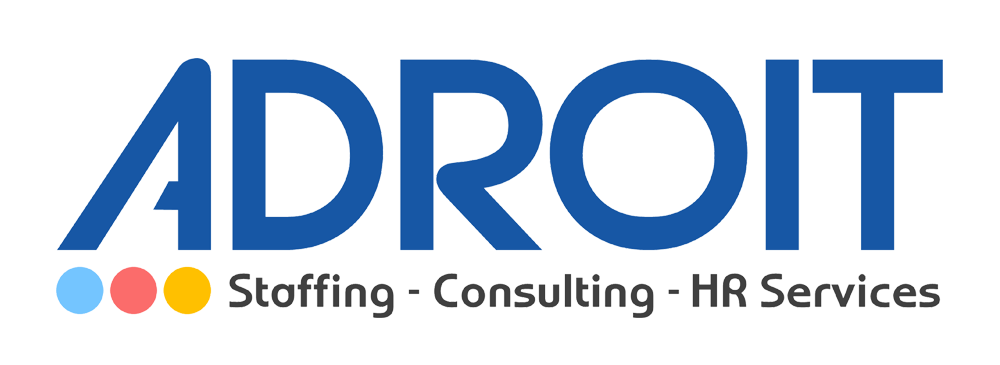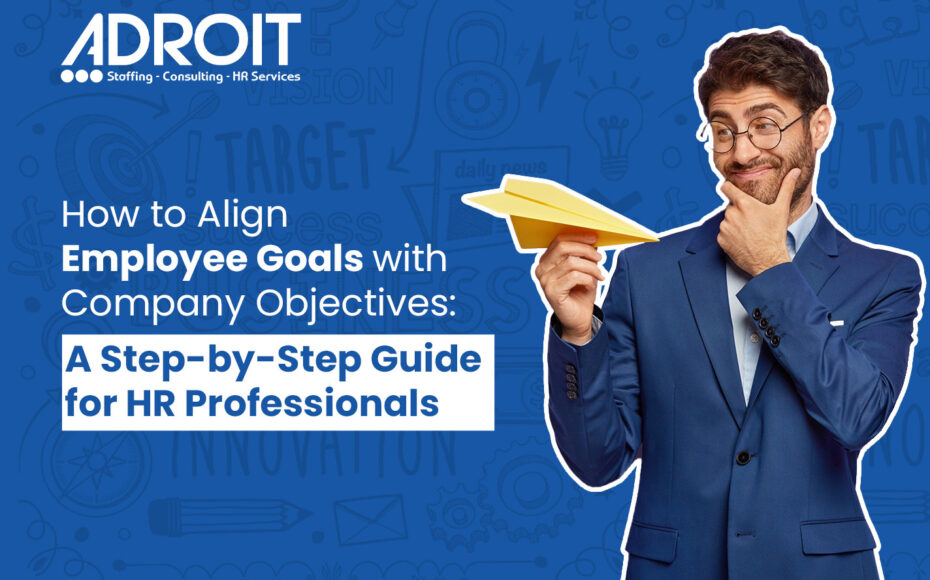Blogs
- Home
- Resources
- blogs
Introduction
Aligning employee goals with company objectives is essential for driving success within an organization. When employees understand how their individual performance contributes to the company’s bigger picture, they are more motivated, engaged, and productive. However, achieving this alignment requires clear communication, effective goal-setting practices, and consistent feedback. In this blog, we’ll explore strategies HR professionals can use to ensure that employees’ goals are aligned with the overall mission and vision of the company.
1. Clearly Define Company Objectives
Before aligning employee goals with the company’s objectives, it’s essential to have a clear understanding of the company’s short-term and long-term goals. These objectives should be clearly articulated and communicated across all levels of the organization.
- Why It’s Important: Employees cannot align their goals with company objectives if they don’t fully understand those objectives. Clear communication ensures everyone is on the same page, which leads to better performance and results.
- How to Do It: Start by working with leadership to identify the company’s strategic priorities. Break down these priorities into specific, measurable goals that employees can relate to. Use internal communications tools, such as town halls or company-wide meetings, to communicate these objectives to all staff.
2. Implement SMART Goals for Employees
SMART goals (Specific, Measurable, Achievable, Relevant, and Time-bound) provide a clear framework for setting goals that are aligned with the company’s objectives. When employees have SMART goals, they can easily see how their work impacts the organization’s overall mission.
- Why It’s Important: Without well-defined goals, employees may feel lost or unclear about how their contributions fit into the bigger picture. SMART goals ensure that employees have a clear understanding of what is expected and how success will be measured.
- How to Do It: Work with employees to set individual SMART goals that directly contribute to company objectives. For example, if your company’s goal is to increase sales, set individual targets for each employee that contribute to achieving that goal, such as increasing client engagement or expanding product knowledge.
3. Establish Regular Check-Ins and Feedback
Aligning employee goals with company objectives is an ongoing process that requires regular check-ins and feedback. By maintaining consistent communication with employees about their progress toward their goals, you can ensure they remain focused and motivated.
- Why It’s Important: Regular feedback helps employees stay on track and provides opportunities to address any challenges or misalignments early. It also reinforces the connection between individual contributions and company success.
- How to Do It: Schedule regular one-on-one meetings between managers and employees to review progress, discuss challenges, and provide feedback. Use performance management tools to track progress and identify areas for improvement. Encourage open and honest communication to address any concerns and realign goals if necessary.
4. Promote a Collaborative and Cross-Departmental Approach
Often, employees work in silos, focusing on their own tasks without considering how their work fits into the larger organizational framework. By encouraging collaboration across teams and departments, you can help employees understand how their contributions fit into the broader company objectives.
- Why It’s Important: Cross-departmental collaboration fosters a sense of unity and shared responsibility for achieving company goals. It also allows employees to see how their work directly impacts other areas of the organization.
- How to Do It: Organize team meetings, workshops, or cross-functional projects where employees from different departments can come together to discuss how their work aligns with company objectives. Encourage knowledge sharing and problem-solving as a collective effort.
5. Incorporate Employee Development into Goal Alignment
Aligning employee goals with company objectives isn’t just about setting targets; it’s also about providing employees with the tools, training, and development they need to succeed. Offering opportunities for growth and skill-building ensures employees are equipped to meet their goals.
- Why It’s Important: When employees have the right skills and resources, they are more likely to achieve their goals and, in turn, contribute to the company’s success. Development opportunities also increase employee engagement and satisfaction.
- How to Do It: Offer training programs, mentorship opportunities, and access to learning resources that help employees develop the skills they need to meet their goals. Incorporate learning and development as part of the goal-setting process and encourage employees to seek out growth opportunities that align with both their personal career goals and company objectives.
6. Recognize and Reward Achievements
Recognition and rewards play a critical role in maintaining employee motivation and ensuring alignment with company objectives. When employees see that their hard work is acknowledged and appreciated, they are more likely to stay engaged and committed to achieving their goals.
- Why It’s Important: Recognition reinforces the connection between individual performance and company success. It boosts morale, encourages continued effort, and strengthens employees’ commitment to the organization’s goals.
- How to Do It: Create a recognition program that highlights achievements tied to company objectives. Offer both monetary and non-monetary rewards, such as bonuses, promotions, public recognition, or opportunities for career advancement. Ensure that recognition is timely and specific, focusing on the impact of the employee’s contribution to company goals.
7. Align Company Culture with Goals
A strong company culture can serve as the foundation for aligning employee goals with company objectives. When the company’s values and mission are deeply embedded in its culture, employees are more likely to feel connected to the overall vision and understand how their individual contributions matter.
- Why It’s Important: Company culture influences employee behavior, decision-making, and performance. When employees feel connected to the company’s values and mission, they are more likely to align their goals with the broader organizational objectives.
- How to Do It: Foster a company culture that emphasizes teamwork, accountability, and shared goals. Make sure that employees understand the company’s values and how their role contributes to the larger mission. Reinforce cultural alignment through onboarding, team-building activities, and leadership communication.
Conclusion
Aligning employee goals with company objectives is a strategic process that requires clear communication, goal-setting, regular feedback, and a supportive work environment. By following these best practices, HR professionals can help employees stay focused on their individual goals while ensuring those goals contribute to the success of the organization. When employees understand how their work supports company objectives, they are more motivated, engaged, and empowered to drive business success.
By aligning employee goals with company objectives, you’re not only fostering a more productive workforce but also positioning your company for long-term growth and success.
Introduction
As businesses grow and evolve, HR management can become increasingly complex. Many business owners turn to HR outsourcing to streamline processes, reduce costs, and access specialized expertise. While outsourcing can offer great benefits, it’s important to fully understand both the advantages and challenges before making the leap. In this blog, we’ll break down the pros and cons of HR outsourcing and help you make an informed decision for your company.
The Pros of HR Outsourcing
1. Cost Savings aaloneloneHR outsourcing can be a more cost-effective solution than maintaining an in-house HR team. By outsourcing, businesses can avoid the overhead costs associated with hiring, training, and compensating an in-house HR staff. Instead, you pay for only the services you need—whether it’s payroll management, compliance, or recruitment.
- Why It Works for Your Business: With HR outsourcing, you get professional services at a fraction of the cost of maintaining a full HR department. This gives your company the financial flexibility to allocate resources to other important growth areas.
2. Expertise and Compliance HR outsourcing providers are experts in labor laws, regulations, and best practices. This ensures that your business stays compliant with ever-changing HR laws and avoids costly fines or legal issues. You gain access to the knowledge and support of professionals without the need to hire additional experts internally.
- Why It Works for You: HR is complex, and compliance is critical. Outsourcing guarantees that your company remains in line with local, state, and federal laws—without the added stress.
3. Focus on Core Business Functions Running a business involves managing a range of tasks, and HR can be time-consuming. By outsourcing HR functions, you can free up valuable time to focus on your company’s core goals, like growing your client base, innovating, and improving products or services.
- Why It Works for Your Growth: Outsourcing HR gives you the time and freedom to focus on strategy and business development, leaving the day-to-day HR operations to professionals.
4. Scalability and Flexibility As your company grows, so does your HR needs. With outsourcing, you can scale services according to your evolving business requirements. Whether you need to recruit more employees or implement a new performance management system, your outsourcing partner can support you with the tools and resources needed for growth.
- Why It Works for Expanding Businesses: Outsourced HR can adapt as you grow, ensuring that your HR solutions are always aligned with your company’s changing needs.
5. Access to Advanced Technology HR outsourcing services often include access to advanced HR technologies—such as HRMS, payroll software, and applicant tracking systems (ATS). These tools help streamline processes, improve efficiency, and provide insights into your HR functions, all while reducing the burden on your internal team.
- Why It Works for Your Business: Technology is the future of HR, and outsourcing can give your business access to the latest tools without the hefty investment in software or training.
The Cons of HR Outsourcing
1. Less Control When you outsource, you give up a certain degree of control over your HR processes. While you can set guidelines and expectations, the day-to-day operations are managed by an external provider. This can sometimes make it harder to stay in the loop and directly influence decisions.
- What to Keep in Mind: Outsourcing HR requires trust in your service provider. It’s important to work closely with your outsourcing partner to ensure alignment with your company culture and needs.
2. Potential Communication Gaps Working with an external HR provider can sometimes lead to communication challenges, especially if the provider is located remotely or operates in a different time zone. Misunderstandings and delays can happen, which may impact your HR functions.
- How to Overcome It: Maintaining regular communication with your outsourcing partner is key. Setting clear expectations, schedules, and check-ins can ensure that things run smoothly.
3. Security Concerns HR involves sensitive information—such as employee data, payroll, and performance reviews. When you outsource, this data is handled by a third party, which introduces the potential for data breaches or security issues if not properly managed.
- Why It’s Not a Dealbreaker: At [Your Company], we prioritize data security. Our HR outsourcing services follow industry-leading security protocols to keep your data safe, ensuring compliance and peace of mind.
4. Less Personal Touch One of the challenges with outsourcing is the potential loss of a personal touch. In-house HR staff often build close relationships with employees, which can help maintain company culture and resolve internal issues more efficiently. Outsourcing might not offer the same level of intimacy.
- Why It Works for Some: For companies looking to streamline processes and focus on the big picture, HR outsourcing ensures efficiency and quality support, even if the “personal touch” isn’t always present.
5. Risk of Dependency Depending on an external provider for critical HR services means that your business could become dependent on them. If there’s an issue with the provider or a change in their services, it could disrupt your HR functions.
- Mitigating the Risk: Choose a reliable outsourcing partner with a strong track record of service continuity. With the right outsourcing team, you’ll have a partnership that supports your business’ long-term success.
Conclusion
HR outsourcing offers clear advantages for businesses—whether it’s saving costs, improving compliance, or freeing up time to focus on growth. However, it’s not without its challenges, like potential communication gaps or losing some control over HR functions. The key is finding the right partner who can meet your needs and help you scale your HR operations efficiently.
At ADROIT HR Services, we offer tailored HR outsourcing solutions that align with your unique business goals. Our experts will guide you through every step of the process, ensuring that you get the most out of HR outsourcing without sacrificing the things that matter most to you







